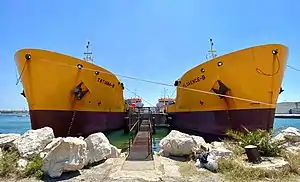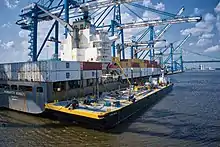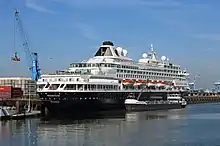

.JPG.webp)

Bunkering is the supplying of fuel for use by ships (such fuel is referred to as bunker),[1] including the logistics of loading and distributing the fuel among available shipboard tanks.[2] A person dealing in trade of bunker (fuel) is called a bunker trader.
The term bunkering originated in the days of steamships, when coal was stored in bunkers.[1] Nowadays, the term bunker is generally applied to the petroleum products stored in tanks, and bunkering to the practice and business of refueling ships. Bunkering operations take place at seaports and include the storage and provision of the bunker (ship fuels) to vessels.[3]
Singapore is currently the largest bunkering port in the world.[4]
Two types of Bunkering
The two most common types of bunkering procedure at sea is Ship to Ship Bunkering (STS) in which one ship acts as a terminal whilst the other moors. The second type is Stern Line Bunkering, which is the easiest method of transferring oil, but can be risky during bad weather.[5]
Bunkering in maritime law
In many maritime contracts, such as charter parties, contracts for carriage of goods by sea,[6] and marine insurance policies,[7] the ship-owner or ship operator is required to ensure that the ship is seaworthy. Seaworthiness requires not only that the ship be sound and properly crewed, but also that it be fully fuelled (or "bunkered") at the start of the voyage.[8] If the ship operator wishes to bunker en route, this must be provided for in a written agreement, or the interruption of the voyage may be deemed to be deviation (a serious breach of contract). If the vessel runs out of fuel in mid-ocean, this also constitutes serious breach, allowing the insurer to cancel a policy[9][10] and allowing a consignee to make a cargo claim. It may also lead to a salvage operation.
The International Maritime Organisation is an agency of the United Nations responsible for the prevention of marine pollution by ships. On 1 January 2020, the agency began enforcing the IMO 2020 regulation of MARPOL Annex VI to minimise bunkering's environmental impact.[11]
References
- 1 2 Manaadiar, Hariesh (August 2011). "What is Bunker and Bunkering". Shipping and Freight Resource. Puthan House. Retrieved 27 June 2016.
- ↑ MOHIT (19 October 2010). "Bunkering is Dangerous : Procedure for Bunkering Operation on a Ship". Marine Insight. Retrieved 16 January 2015Site seems to require enabling of cookies.
{{cite web}}: CS1 maint: postscript (link) - ↑ "Bunkering". Maritime and Port Authority of Singapore (MPA). Archived from the original on 7 January 2015. Retrieved 16 January 2015.
- ↑ "Page 143 - WOO 2014". www.opec.org. Retrieved 2020-11-24.
- ↑ "Bunker Fuel Solutions for Marine Vessels | Dan-Bunkering". dan-bunkering.com. Retrieved 2023-06-28.
- ↑ See the United States' Harter Act
- ↑ Marine Insurance Act 1906
- ↑ The Hague–Visby Rules Articles II & III
- ↑ Greenock Steamship Co v Marine Insurance [1903] 2 K.B. 657
- ↑ If the policy has a "held-covered" clause, the deviation will not allow immediate cancellation
- ↑ "Air Pollution". www.imo.org. Retrieved October 14, 2020.
